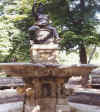|
Samson
and a Philistine

Image reproduced by
kind permission of The Victoria & Albert Museum Picture Library, London
In 1953 the Victoria & Albert
Museum purchased the great marble sculpture of Samson and a Philistine (1) by the Flemish
sculptor Giovanni Bologna, known as Giambologna (1529-1608) for the nation due to the
efforts of the late Sir John Pope-Hennessy (former director of the Victoria & Albert
Museum) and the story of this much travelled statue provides the essential background to
the matter before us here. It has a fascinating history (2).
It was carved in 1562 for Prince
Francesco de Medici and in 1569 was incorporated to crown a small fountain set up in the
courtyard of the Casino Medicio opposite the convent of San Marco, Florence. Fifteen years
later the fountain was dismantled (1584) and in 1601 it was shipped to Spain as a
diplomatic gift by the Medici to the Duke of Lerma, favourite of King Phillip III. The
Medici had strong links with Spain and gifts were given out of self-interest, after all
the Medici started out as bankers and always wanted to enhance their status. Phillip II
discouraged gifts of this kind but with the arrival of Phillip III on the throne in 1598
this all changed.
The Duke of Lerma

In 1623 the Samson and a Philistine
was given to our Prince of Wales (later Charles 1) while he was in Spain trying to arrange
a Spanish marriage and he gave it to the Duke of Buckingham who accompanied him on this
unsuccessful trip. Before finding a home in the Victoria & Albert Museum this statue
with its Royal connections was sometime in the garden of York House (3), where it was
known as Cain and Abel, then Buckingham House – later Palace, where it was given away
by George III in 1762 to Thomas Worsley, Surveyor General of His Majesty’s works, and
taken to Hovingham Hall, Yorkshire (4). It is 6 feet 10 inches high, of Carrarra marble,
weathered and restored with stainless steel bolts inserted in the legs, and still much
copied today by art students (5).
The Fountain at
Aranjuez

The fountain remained in Spain
(Valladolid) and was later removed to the Royal Gardens of Aranjuez (Jardin de la Isla)
where it remains today among other fountains in a lovely setting surrounded by trees.
Aranjuez, that oasis in the Castilian wilderness created by Phillip II, that
self-appointed champion of the Catholic church who sent the Spanish Armadas against
England but who loved the paintings of Titian, missed the song of the nightingale when he
was in Portugal and could write to one of his daughters "The yellow jonquil that they
have brought you from Aranjuez is a wild flower; I believe that comes out earlier in the
fields than in the garden although it is not as fragrant." (6) |